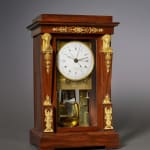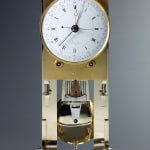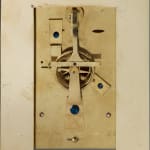Robert Robin Fils
Further images
Provenance
Richard Redding Antiques, Zurich. The Vitale Collection, purchased from the latter during the early 1990s. Thence to a private Swiss collector.
Literature
Derek Roberts, “Precision Pendulum Clocks”, 2004, p. 77, pl. 29-13, illustrating an Empire regulator with annual calendar by Jean-Simon Bourdier, likewise with a Dubuisson dial and housed in an almost identical gilt bronze mounted mahogany case, now in the Patrimonio Nacional, Madrid. And p. 99, pl. 31-14B, illustrating an Empire regulator with annual calendar and equation of time by Lory à Paris, again housed in an almost identical mahogany case.
An important Directoire gilt bronze mounted mahogany precision table regulator of month duration by Robin Fils à Paris with a very fine enamel dial by the eminent enamellist Etienne Gobin, known as Dubuisson, signed on the white enamel dial above 6 o’clock Robin Fils and below 6 o’clock Dubuisson, also signed and dated on the backplate Robin Fils à Paris an 7 1799 and further engraved on the gilt brass plate below the dial with the entwined initials ‘RR’. The dial with Roman and Arabic numerals for the hours and minutes, with an inner seconds ring and outer calendar rings marked with the names of the months of the year beside their appropriate symbols, below which are the corresponding numbers in each month marked 10/20/30 or 31 and in the case of February: 28, with a fine pair of Breguet-style brass hands for the hours and solar minutes and blued steel pointers for the sweep centre seconds, mean time minutes and calendar indications. The twin barrel movement mounted upon a detachable brass frame which perfectly fits within the mahogany case, with Graham anchor escapement, equation and remontoire and knife edge suspension for the massive free swinging nine rod gridiron compensated pendulum with five steel and four gilt brass rods mounted below with a brass temperature plaque marked 10/5/0/5/10/ Froid/Tempere/Chaud and inscribed Elementa Suis Propriis Armis Victa, above a large brass bob at the base of which is a screw to adjust the pendulum regulation. The rectangular pedestal mahogany veneered case with glazed sides and front opening door, the frieze centred by an anthemion mount above the dial which is flanked either side by gilt bronze busts of Classical female caryatids with their hair worn in plaits, on tapering pilasters with palmette mounts terminating in gilded feet on rectangular bases each mounted with a winged Victory that stands upon clouds, the whole on a stepped base with block feet
Paris, dated 1799
Height 46 cm, width 28 cm, depth 20 cm.
This exceptional precision regulator, made at the close of the eighteenth century by Robin Fils of Paris, is one of the finest of its kind. Not only is the movement of the highest standard but it also features a dial painted by one of history’s finest enamellers namely Etienne Gobin, known as Dubuisson (b. 1731 d. after 1815). Furthermore it is housed in a very elegant gilt bronze mounted case.
The case model was evidently popular and was used by a number of other leading late eighteenth and early nineteenth century clockmakers, however the present example appears to be one of the earliest of its type. Among near identical examples one can cite an Empire regulator made by Jean-Simon Bourdier, likewise housed in a mahogany veneered case and fitted with a dial by Dubuisson, which is conserved in the Spanish Royal Collection. Another near identical model with its dial signed Galle appeared in a sale at Versailles (Palais des Congrès 19th November 1989, lot no 94) while another with slight variations was in the collection of the Spanish born fashion designer Cristobal Balenciaga (sold Sotheby’s Monaco 4th December 1983, lot 64). In addition Richard Redding Antiques previously sold a table regulator of 1812 by Pierre-Basile Lepaute housed in a burr elm case of the same model and mounts but without the glazed front.
The complex precision movement was made by one of the leading Parisian firms of the day, namely Robin Fils. This firm, sometimes known simply as Robin or Robin Frères, was founded by Louis XVI and Marie-Antoinette’s favourite clockmaker Robert Robin (1741-99) who made a number of high quality regulators and other precision clocks. After his death in 1799 (the year that this clock was completed), the business was continued by his sons: Nicolas-Robert (1775-1816) and his younger brother Jean-Joseph (1781-1856). They have been described by Jean-Dominique Augarde as “brilliant clockmakers in their own right”. Together they successfully continued their father’s business during the early nineteenth century. During that time they often showed their work at the leading exhibitions where they won a number of awards, for instance at the Exposition des Produits de l’Industrie in 1806 they won a medal and then after Nicolas-Robert’s death in 1816 his brother, as head of the business, was awarded another medal in 1819 at the l’Exposition des Produits de l’Industrie Française. At the latter exhibition, the jury was keen to make known that Jean-Joseph Robin enjoyed the same status as his father, noting that “Mr. Robin Fils presented two very finely executed astronomical clocks; He maintains the high reputation earned by his father’s numerous and important works. The jury considers that Mr. Robin is still very worthy of the 2nd class silver medal, equivalent to the bronze medal that he was awarded at the last exhibition’ (“Rapport du jury de l’Exposition des Produits de l’Industrie Française”, 1819, Sect. III., ‘Horlogerie Astronomique”, p. 251). With the restoration of the Bourbon monarchy came more accolades when Jean-Joseph Robin was appointed clockmaker to the King as well as Louis XVI’s daughter under the respective titles Horloger du Roi and Horloger de Madame la duchesse d’Angoulême.
Since the present regulator was completed in the same year that Robert Robin died - 1799 (which was the Republican year 7, as also stated on the backplate), it can be assumed it had been begun by Robert Robin himself with the assistance of his sons who, after their father’s death, then added their own name when assembling the final piece. This was not unusual since the individual parts, to include the complex mechanism, dials and case, would have taken a year or so to construct and assemble. On other occasions Nicolas-Robert and Jean-Joseph Robin, working at Saint-Honoré n°320, adapted some of the earlier clocks made by their father signed Robin aux Galeries du Louvre à Paris, as in the case of a regulator now in the Lambinet Museum in Versailles (Inv. 947). When that regulator was included in an exhibition at La Chaux-de-Fonds, Musée International de l’Horlogerie in 1989, the exhibition curator Catherine Cardinal explained how the two sons re-adapted the dial and movement to the latest standards, noting that “One of Robin’s sons, who affixed his name to the present dial, converted the dial and movement, after 1805, to be compatible with the duodecimal hour and Gregorian calendar” (La Révolution dans la Mesure du Temps: Calendrier Républicain, Heure Décimale 1793-1805”, La Chaux-de-Fonds, Musée International de l’Horlogerie, 1989, p. 68).
As a reflection of the clock’s importance the dial was made by Dubuisson who, with Joseph Coteau (1740-1812), was one of the finest painters of highly ornamented dials and enamelled clocks during the late eighteenth and early nineteenth centuries. Born in Lunéville, Dubuisson worked firstly as a porcelain painter in his hometown as well as in Strasbourg and Chantilly. Like Coteau, he was employed at Sèvres, where from 1756-9 he worked as a flower painter before specializing on his own account by supplying the finest enamelled watchcases and clock dials to the leading clockmakers of his day.
It is significant that in addition to Robin Fils, Dubuisson supplied enamelled dials and plaques to their father Robert Robin, who still owed Dubuisson 725 francs on his death (as did Galle who on his death in 1815 still owed Dubuisson 120 francs). In addition to them Dubuisson worked for other celebrated makers including Dieudonné Kinable, Jean-Simon Bourdier, Louis Berthoud, Pierre-Basile Lepaute as well as Antide Janvier. During the 1790s Dubuisson was recorded in the rue de la Huchette and later in circa 1812 at rue de la Calandre as well as rue des Lavandières Sainte-Opportune.
As one of the leaders in his field, Dubuisson won the respect of many. For instance when Louis Berthoud described one of Dubuisson’s dials showing decimal time, he noted that it “can be regarded as a masterpiece of outstanding craftsmanship” (Jean-Dominique Augarde, “Les Ouvriers du Temps”, 1996, p.103). Likewise, Antide Janvier praised Dubuisson’s set of intricate dials, made for one of his astronomical clocks, noting “The dials are executed by citizen Dubuisson, who unites the greatest dexterity in his art with a knowledge which guarantees the success of the most difficult pieces: it is a real service to collectors to tell them of this modern and hardworking artist”. (Ibid, p. 104 and illustrated pp. 106-7). At a later date Janvier also wrote “I liked M. Dubuisson as an artist, before learning to admire him as a good father, good friend and good citizen, He is a worthy man in every respect.” (Ibid., p. 104).
It can also be assumed that Dubuisson painted the enamel temperature plaque which bears the Latin inscription Clementa Suis Propriis Armis Victa: (which can loosely be translated as ‘The elements are defeated by their own weapon’). Such an inscription also appears on thermometer bands on a few other quality French regulators, including ones by Ferdinand Berthoud, Verneuil, Collin, a pupil of Lépine and significantly Robert Robin.





